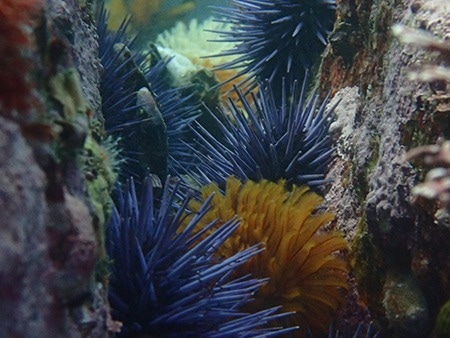It was the appearance of sea urchins from their hiding spots, not an increase in the urchin population, which caused a spectacular outbreak of kelp-eating sea urchins along California’s Central Coast in 2014. This resulted in a large decline in the region’s kelp forests.
 Purple sea urchins hidden in a reef crevice. Image Credit: Michael Langhans
Purple sea urchins hidden in a reef crevice. Image Credit: Michael Langhans
Sea urchin migrations in succeeding years allowed “urchin barrens” to reclaim their kelp forests.
These are some of the main outcomes of a thorough investigation of the dynamics of the kelp forest and sea urchin populations in Monterey Bay carried out by researchers at the University of California, Santa Cruz.
The new research, which was published on June 29th, 2022 in Ecology Letters, could support efforts to rebuild decimated kelp forests along the California coast, according to Joshua Smith, who oversaw the study as a UC Santa Barbara Ph.D. student and is now a postdoctoral researcher at the National Center for Ecological Analysis and Synthesis.
As people are thinking about practical ways to facilitate kelp forest recovery, most people would agree we need to reduce the number of sea urchins, but it is also really important to consider the role of sea urchin behavior.
Joshua Smith, Postdoctoral Researcher, National Center for Ecological Analysis and Synthesis, UC Santa Barbara
Using data from 22 years of long-term monitoring, Smith and co-author Tim Tinker, an adjunct professor of ecology and evolutionary biology at the University of California, Santa Cruz, demonstrated that the 2014 outbreak of purple sea urchins in southern Monterey Bay was primarily caused by a behavioral change rather than a population increase.
They observed the foraging habits of sea urchins over the following three years in the region, which had transformed into a patchy mosaic of kelp forests and urchin barrens. They discovered that the behavior of sea urchins was related to changes between the two states in both directions.
Ecosystem Disruptions
The development of sea star wasting disease, which took out a sea urchin predator known as the sunflower sea star, marked the start of a string of severe changes to the ecosystems of California’s kelp forests.
The next year, a remarkable maritime heatwave showered the shore in warm water, which made it difficult for the kelp to grow. This paved way for the unparalleled sea urchin epidemic. All of sudden, purple sea urchins were feeding on the living kelp on the rocky reefs where kelp forests had grown.
According to Smith, sea urchins often graze on kelp debris that floats their way on the currents while hiding from predators in the cracks and crannies of the rocky reef. The typical food delivery was not occurring owing to the warm water’s lower kelp yield, and at the same time, a noted sea urchin predator had vanished.
Smith added, “In 2014, they came storming out of the crevices looking for kelp. These were big adult sea urchins that showed up all of a sudden, especially in central and northern California, and that behavioral shift here along the Monterey Peninsula led to these urchin barrens where there had been kelp forest.”
Smith and his colleagues, in a previous study, demonstrated that sea otters’ predation on sea urchins helped preserve pockets of healthy kelp forest in Monterey Bay. The kelp forests in northern California, where there are no sea otters, are nearly extinct.
Smith and Tinker’s latest study revealed no indication that the number of young sea urchins increased unusually in 2014. However, sea urchin “recruitment” (the influx of young urchins into the population) did rise in the following years, and as a result, there are now more sea urchins than there were before 2014, according to Smith.
Recovery
However, scientists discovered that kelp forests can regenerate if sea urchins abandon a reef. For instance, in 2018, they visited a location that had been devoid of urchins the year before and discovered a kelp forest. The sea urchins had migrated into shallower water where red foliose algae were abundant, away from the reef that they had stripped of kelp.
“They prefer kelp, but they had eaten all the kelp, so they moved up into shallower water and that allowed the kelp to regrow on the deeper reef. Interestingly, the kelp that came back was bull kelp, not the giant kelp that is typically dominant on the central coast,” stated Smith.
He stated that this year’s water conditions are ideal for kelp development. Substantial upwelling of cold, nutrient-rich water has been caused by an extremely stormy spring along the coast.
Smith concluded, “We are all waiting to see how that impacts kelp recovery. There are just a lot more sea urchins now out on the reefs actively grazing, so we need to consider how we might get their numbers back down and enough predation to drive them back into the crevices.”
The National Science Foundation funded this study.
Journal Reference:
Smith, J. G., et al. (2022) Alternations in the foraging behaviour of a primary consumer drive patch transition dynamics in a temperate rocky reef ecosystem. Ecology Letters. doi:10.1111/ele.14064.